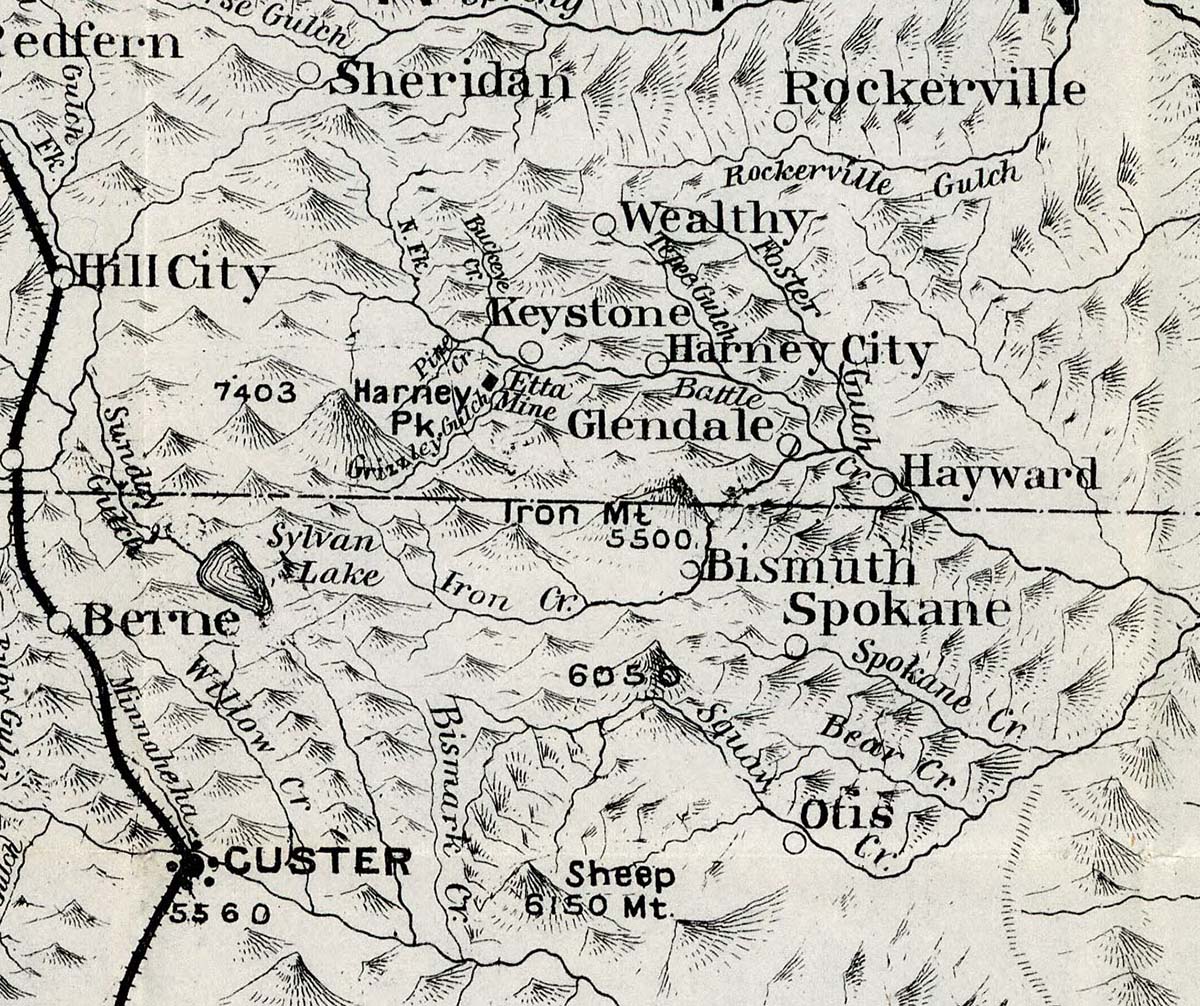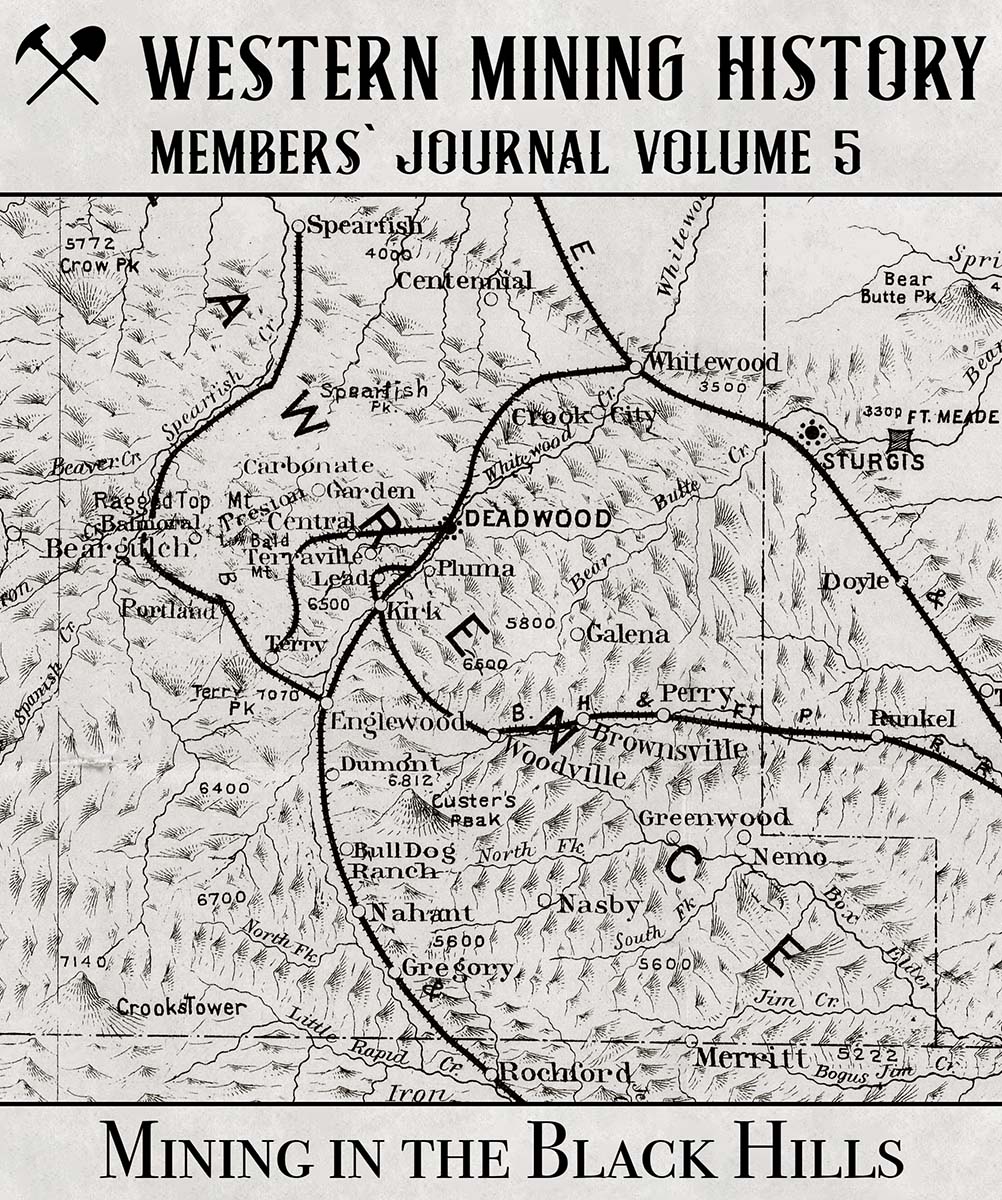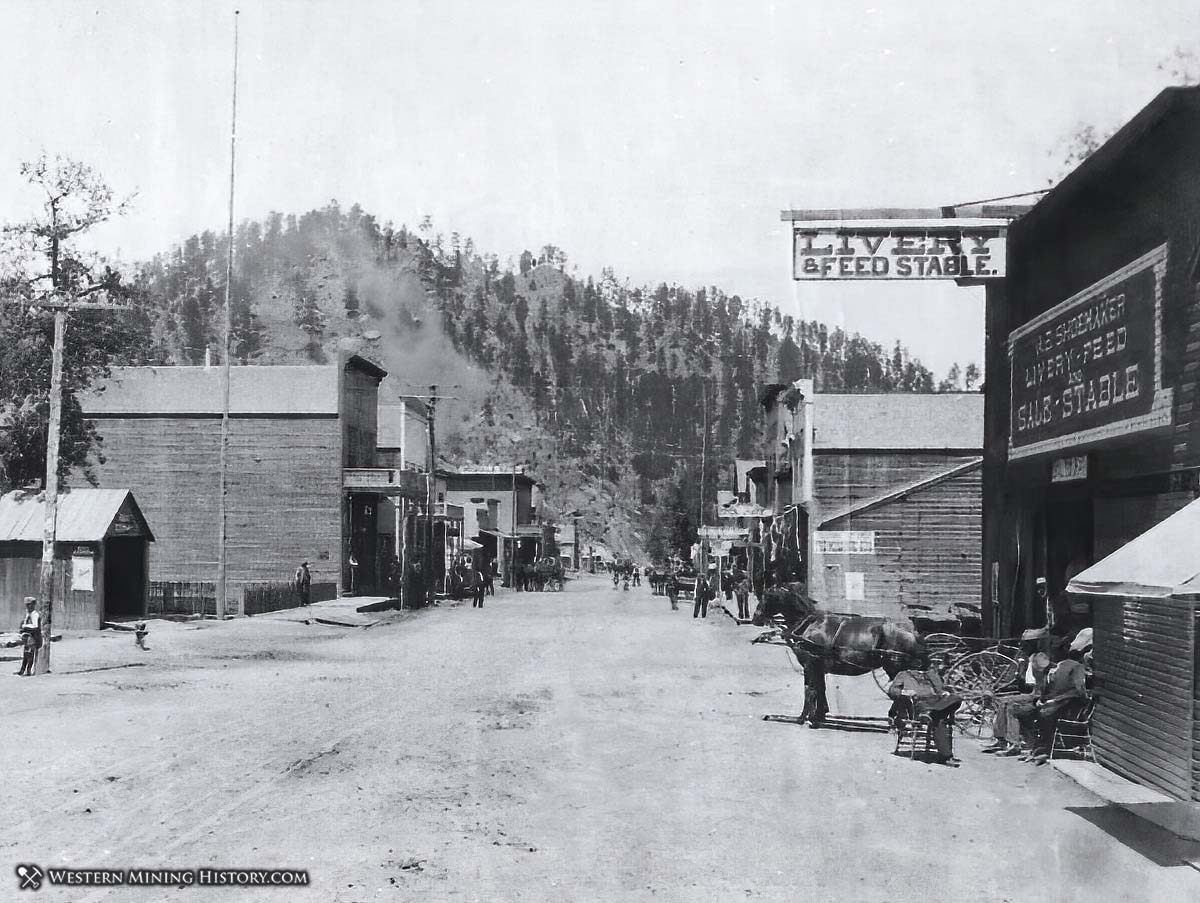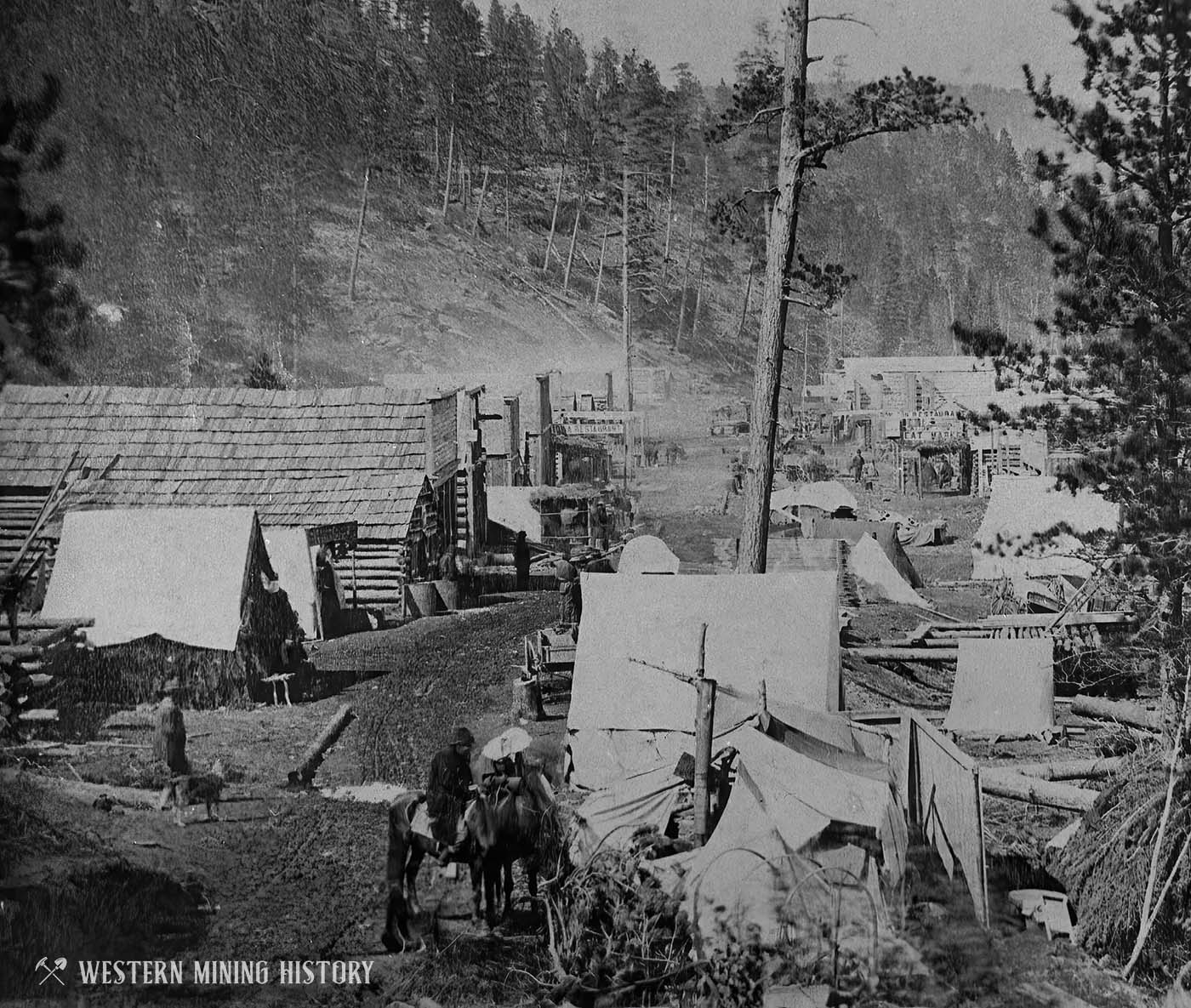Keystone History
Although Keystone was established as a minor placer camp in the 1870s, and some lode mining activity occurred in the 1880s, it did not become a stable community until the early 1891 when the Keystone mine was discovered. The discovery of the Holy Terror a couple years later added further stability to the town.
In 1898 the Keystone was sold to the Holy Terror Company. The combined properties have been the largest gold producers in the southern Black Hills. The success of the mines justified the expense of building a railroad to the town, which was completed in 1900. Around this time the population of Keystone peaked at over 2,000 residents.
The Holy Terror mine reached a depth of 1,200 feet by 1903. However, that year the mine ceased operations as a result of litigation stemming from the numerous death of miners that was blamed on poor safety practices, and due to increasingly problematic water levels in the mine.
A variety of factors helped keep Keystone a viable community when other mining towns were abandoned. In the 1920s the mining of feldspar became economically viable, and a feldspar grinding plant was built near the town. The 1920s also saw a brief resurgence of gold mining in the area. Beginning in 1927, construction of the Mount Rushmore monument provided jobs for Keystone residents. The Holy Terror mine was put back into production from 1938 to 1942.
The business district of Keystone was repeatedly destroyed by fires in the years 1908, 1917, 1921 and 1937.
Today, Keystone remains a popular tourist destination. A post office was established at Keystone in 1892, and still operates today.

Keystone Described in 1904
The text below is from the 1904 publication Black Hills Illustrated.
Probably the most typical mining camp to be found in the Black Hills to-day is the town of Keystone, in the central and eastern part of the Black Hills and located in Battle Creek valley, practically a one-street town, with hills on both sides and quartz mines on either hand, many of them right in the town itself. Keystone was first located as a placer camp in 1876 and the celebrated Mitchell bar was discovered in 1881.
The first stamp mill was built in 1880 for the Cross mine. It was of ten stamps. The first producing quartz discovery, however, was the Holy Terror in 1894 by William B. Franklin and his little adopted daughter. Mr. Franklin had promised to name the mine after his wife, who in consequence expected it to be called the "Lucy." He did name it after her, but not in the way she had expected.
The Holy Terror produced the highest grade of gold quartz ever found in the Black Hills and paid its first owners over $32,000 before they sold it to the present company, which has paid about $172,000 in dividends. Alleged lack of precautions led to many accidents and the consequent death of a number of the employes, resulting in litigation and judgments against the company to such an extent that in the summer of 1903 the mine was closed down, but it is well known that gold is even more abundant at the lowest level- 1,100 feet-than at the top, and the mine will undoubtedly resume operations in the near future.
Franklin & Reed had built a small prospecting mill at Keystone before the Holy Terror was discovered.
At the present time some excellent properties in the town and surroundings are developing and making an excellent showing. Among them are Col. Clark's syndicated properties and the Bismark, Bullion, Lucky Boy, Tycoon, the Tom Custer, the Butte, the Juniper, the Bagdad, the Dora Belle, the Columbia and the Cross mine group, all mentioned elsewhere.
The town has an altitude of 4,220 feet and the population is about 1,200. The water supply for drinking purposes comes from wells, but the city water is supplied from the Holy Terror mine, which pumps the water from its own mine into settling tanks from which a six-inch iron water main has been built all over the city.
The city is not dependent upon mining by any means, having a splendid backbone in the fine cattle and farming ranges which abound in the valley parks. The timber industries and sawmills in the immediate neighborhood also contribute largely to its business. There are two general stores, both carrying large stocks, as well as hardware, and several blocks of individual business supplies.
A very excellent hotel called the McDonald contains 26 rooms and is managed by George D. Willis, an architect by profession, who is also the superintendent of the Butte Mining and Milling Company, a 75-acre claim near the Bismark. The fire department is entirely volunteers and consists of 40 members.
There are four churches, the Congregational, Methodist, Catholic and Baptist. The Episcopalians have services monthly in the Methodist church.
One of the finest school buildings in the state is the Keystone public school, which cost $10,000. It accommodates 300 children, employs five teachers and has four recitation and five school rooms. The grades run from the first to the eighth and pupils graduate to the normal school at Spearfish.
Societies are well represented and they consist of the Masons, Knights of Pythias, Odd Fellows, Woodmen, Agrarians and A. O. U. W.'s. The ladies have the Eastern Star, Daughters of Rebekah and Royal Neighbors. The Keystone Club, a social organization of the business men of the city, consists of 30 members and is rapidly increasing.
The Keystone Bank was incorporated January 2, 1900, with a capital of $10,000 and the following officers: James Halley, president; J. J. McNamara, vice-president, and W. H. Gates, cashier. At the close of business November 17, 1903, the surplus and profits were $2,528.26; the deposits were $56,277.88.
The Keystone Bank has as associate banks the First National Bank of Rapid City and the Bank of Hot Springs, Hot Springs, S. D. Mr. James Halley is interested in both of these banks and the Keystone Bank has the benefit of his great experience in financial matters.
Mining in the Black Hills

Western Mining History Member's Journal Volume 5: "Mining in the Black Hills", takes a closer look at the distribution of mining districts and towns the Black Hills of South Dakota.
Deadwood: The Ultimate Photo Collection
The Black Hills Gold Rush was one of the most significant historical events in the western United States. Deadwood: The Ultimate Photo Collection contains over 50 images capturing the early history of this famous gold region.

